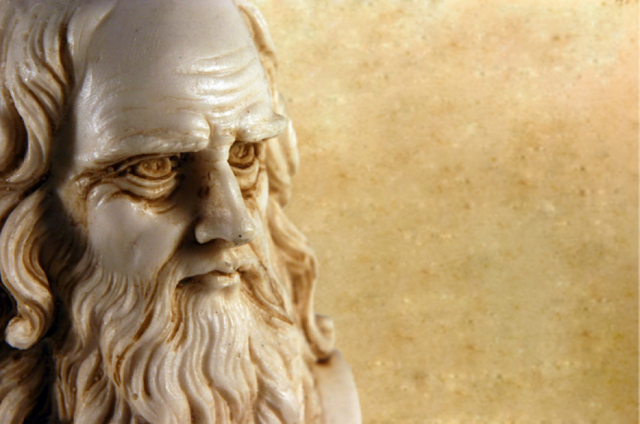Life and Creativity of Leonardo da Vinci /part 2/
In the year 1500, Leonardo went to Mantua, where he painted the portrait of Isabelle of the Estonian family, who would in vain attempt to place other orders in Venice, where the artist stayed for a few days. He then settled in Florence, where he remained until 1506, and in the meantime, in 1502, he was recruited by Cesare Borgia. His creative work is shared between painting: a preparatory sketch for St. Anne, Mona Lisa, Leda, the impressive composition "The Battle of Angignari", commissioned at the end of 1503 year, prepared up to 1505, painted in the summer and abandoned) and between engineering projects for military equipment: the fortification shafts in Arno and Piobo. Leonardo again returns to the "Treatise of Painting", which began most probably between 1487 and 1492, on which he worked until 1513. From 1506, he shared his work in Milan; he went to work with the French, specifically Charles de Amboise, and his engagements in Florence, where he worked for the Senery, and was later occupied with the inheritance case, which He leads with his brothers. He goes back to the horse-drawn statue, this time for the Trivulche Contirator, making small panes (not available to us) with images of the Madonna for King Louis XII, working on the second version of "The Virgin in the Rocks", completes the picture "St. Anne" . Meanwhile, he has conducted a series of scientific observations and research in the fields of anatomy, mathematics, architecture and scenography. In 1513 Milano finally left the city after being captured by the troops of the anti-French coalition.
In Rome, he is placed in Belvedere as he enters the environs of Juliano Medici, the brother of the then Pope Leo X. He dedicates himself to his research in the field of Mathematics and Optics. But his patron Giuliano died in 1515, and Leonardo, eager to leave Rome, as Rafael and Michelangelo reigned there, accepted at the end of 1516 the invitation of the French King François I. In 1517 he settled in Amboise, in the magnificent villa of Klu, and was appointed by the King as "Chief Royal Artist, Engineer and Architect". He resumed the sewerage and building projects of the French city of Romorantn, preparing the sketches for the royal decorations that took place in the spring of 1516. He brings to France most of his paintings and all his working papers, which he will bequeath to his faithful student and companion Francesco Meltsi. His journals make it clear that he "studied the ingredients of the water, the machinery of some machines and other objects" by using the traditional language, and hoped that when his research was published, it would be of great help. It took four centuries to make Leonardo da Vinci's pre-death wish. The publication of Amboaz's will has been delayed and concealed for various reasons.
Most explorers of Leonardo's life claim that he was a handsome man with a very pleasant radiance, a fascinating interlocutor, a generous man. Today we have a self-portrait of the artist painted with a red pencil around 1512 when his author was 60 years old. We have no other reliable document about his external radiance. From the later drawing of Vasari (1557) and from the work of Christophoro Coriolano (1558), we find that Leonardo wore a long beard, his face crowned with long hair - an atypical hairstyle for that era. It is believed that Vasari consciously wanted to give Leonardo the look of an ancient sage and thus brought him closer to the traditional presentation of the ancient Greek philosophers Plato and Aristotle (cf. the composition of Rafaello "The School of Athens" /. The sharper consciousness of the self is often noted in Leonardo da Vinci's psychology. Naturally, the question arises as to how much he has committed himself to building his own personality. Perhaps he has sought the ideal model of a sage-magician or the archetype of a philosopher possessing technical skills that is likened to Hermes and honored by humanist neoplatons. There are no intimate reflections in Leonardo's diaries. But there are quite scornful assessments of psychological functions in man, human insanity that repels the curiosity of the able to learn all the functions and describes all the lusts of a researcher. There is no doubt about Leonardo's homosexual inclination. In 1476, in Florence, he was accused of practicing sodomy / debauchery with men. Later, when he was in Milan, he was surrounded only by young men, and in 1491 he described with disconcerting detail in his diary the charms of young Salaj, whose clothes he was worried about, as well as his presence in his company. No more is known.

I admire him because Leonardo's genius is evident from the many fields he has mastered. He is a painter, sculptor, inventor, researcher, engineer, anatomist, mathematician, plant and animal expert, optician, aerodynamic, and even a capable musician. He learns without limits. Of course this is not hard because he does not work hard, he just "have fun". To paint humans, he specifically studied the anatomy of the human body. Leonardo is probably the craziest learner. While studying anatomy, he likes to go out at night, dismantle the grave, and pick up the corpses of unfamiliar people who are almost rotten and dissect them. Sometimes he did it in the hospital that gave him permission. He really wants to know why the human body is shaped like that. That way, he can be more detail in making his paintings.
Nice writing
thanks
You got a 10.85% upvote from @postpromoter courtesy of @godflesh!
Want to promote your posts too? Check out the Steem Bot Tracker website for more info. If you would like to support the development of @postpromoter and the bot tracker please vote for @yabapmatt for witness!
Leonardo had a very amazing life, his works were controversial.